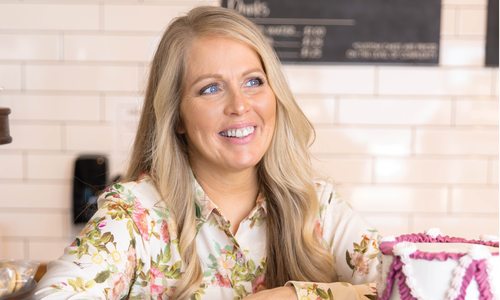Profiles
Five Questions with Amy Vaughan
An occupational therapist uses nearly two decades of expertise to create a book that can give every parent the tools they need to help their kids thrive both in school and out.
By Katie Pollock Estes | Photo by Brandon Alms
Mar 2015

Amy Vaughan has spent the past 18 years working as an occupational therapist with a focus on children. Her office is at Burrell Behavioral Health, and between her experience working with kids who have a variety of needs and being part of the diagnostic assessment team for Burrell Autism Center, she knows a thing or two about how our sensory experiences shape our daily lives—from childhood right on into adulthood. Her book, Positively Sensory!, is filled with education, learning assessments and actionable tips for parents who want to help their children learn to learn, to fill their days with activities that are good for their brain power and to give them what they need to succeed in every stage of their lives. And while the book is aimed at teachers, professionals and parents who have children who are struggling, the book’s tips are applicable to every kid out there. Even parents whose kids are already thriving can learn to take their child’s development and education to the next level.
417 Magazine: Sensory has been a big part of your career as an occupational therapist for so long, what made you decide to finally write a book about it?
Amy Vaughan: Parents would email me and say, “I have this question.” Then another parent would ask the same question. I thought, I don’t have a favorite book I can hand you that has all the answers to the questions you asked me—everything from learning style and setting a child up for success to harnessing attention and avoiding meltdowns in public. So I just decided to sit down and write it. It’s set up so that at the end of each chapter you have a deeper journey—questions that help you apply it to your own child as you go along.
417: Can you explain what sensory means, and why positive sensory experiences are important?
A.V.: Sensory can feel a little mystical because we don’t talk about it often, but we all live through it every day. All of our memories are sensory. What makes your most enjoyable memory so awesome? The way it felt. The way it felt to do it, see it, touch it, hear it. We all have sensory preferences, but when kids’ preferences become so rigid that they cannot go to the beach with a group of friends because they don’t like the feeling of sand on their feet, then it limits them socially. I care about that. I care if your sensory preferences limit what you do during the day, the skills you develop and the opportunities you have to become what you want.
417: How does the book help parents navigate struggles at home?
A.V.: The book lays out principles and foundations so you know how to look at situations in a different way. And it offers ideas for actionable changes, so you can do things differently. You go from recognizing, “Oh, I just set up the perfect storm for a meltdown” to “I see! I can set up the perfect party instead, and we won’t melt down. I totally see how to change this situation at bedtime.” It’s tailored for gaining cooperation, not just compliance. You can gain compliance and not be winning your ball game.
417: Can you explain the difference between cooperation and compliance?
A.V.: When we’re raising kids, we can shut down behaviors that we don’t like, and they will be quiet and still. But then we’re raising couch potatoes, and that’s not really want we want. We don’t want kids to be still, be quiet, stop asking questions, stop touching things, stop exploring. We really want kids who appropriately explore, discover and are curious. Who engage and interact. Especially coming from an autism world—if a child is shutting down and not interacting, that’s not what we want. The book is tailored to gaining cooperation, so you’re on the same team. You’re going forward with a behavior you do want to see. Not just stopping a behavior you don’t want to see. There’s a big difference between those two things.
417: Can you talk about the importance of exploration and play?
A.V.: There’s a huge neurological purpose behind having fun. Just like your body needs food to have enough energy to get through your day, your brain needs enriched activity to grow. I think there’s a myth out there that just providing some technology for learning the ABCs is really great stimulation, but we’re replacing certain whole-body activities—the movement, the running and playing, the digging our feet in the sand—with less sensory activity. So what we’re seeing is that by the time children get into grade school, that has made a difference in their academic performance, in their rigidity in the way they learn. We can tell that they haven’t had much sensory experience. Sensory activities are not just for kids who are struggling. They are for every kid. Sensory activities are usually nutritious brain activities that feed the nervous system.
The other thing to know is that fun triggers the brain into learning the way other things don’t. So if you’re having fun doing it, it files away as a richer experience, a richer memory, and you’re motivated to follow that train to more learning and more fun.












